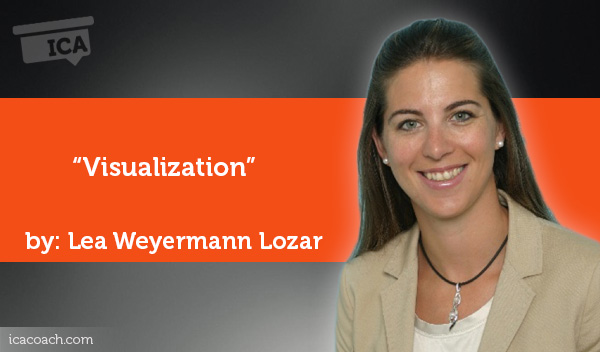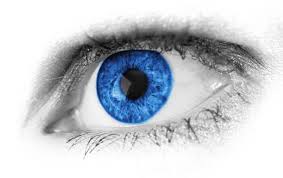
Research Paper By Lea Weyermann Lozar
(Business Coach, SWITZERLAND)
When you see it, you believe it, when you act on it, you live it.
Visualization followed by action

The clearer you are when visualizing your dreams, the brighter the spotlight will be to lead you on the right path. Gail Lynne Goodwin
Introduction
I have become familiar with visualization very early in my sporting career. This was more by coincidence and with very little knowledge. Yet, I now know how powerful it is, even much more when used properly. As an alpine ski racer, I memorized the course settings and before the performance “skied” the course in my mind several times as part of the preparation for the race. At age of about 15, I draw a picture of the Olympic Games where I held the 1st place and hang it on the wall to be reminded every day of what I can achieve. It was so unbelievably real and detailed. I have written “I can” on purpose because the Olympic Games remained an unfulfilled dream despite having a quite successful career. Thinking of it now and why it remained unfulfilled was due to several circumstances, including lack of constructive action, clear distinction in my mind between what “I can” versus what “I want”, and support systems, like a mental coach, that would help me on that desired journey to make my vision come true.
What is Visualization?
In short, it is a snapshot of a person somewhere in the future when the dreams, aspirations, goals, desires come true. It can be a year or two from now, but also further down the line, like five or ten years later. We start at the end (the desired outcome) and then work backwards to find strategies that will support us to reach our goal. The focus should not solely be only on WHAT we want to achieve or own, for example more wealth, a fancy sports car, a beautiful house, a dream job, etc. It is also important to focus on WHO we are/want to be in that future moment, which needs to be aligned with our values.
The power of visualization has been also scientifically proven. It is a well-known fact that we stimulate same brain regions when we visualize an action and when we actually perform that same action. Visualization can in this sense be seen like a practice and once we do get to perform that same action it gives us sort of a “Déjà vu” experience; we have already been there before, have done it in our mind, and have this sense of familiarity once faced with the real situation.
How do we ensure that the information reaching our conscious mind is supporting us in achieving our goals? Neuroscience suggests that the brain’s Reticular Activating System (RAS) acts as a filter for our brain to ensure that we don’t deal with more information that we can actually process. It is so to speak the gatekeeper of information that is let into the conscious awareness. With using visualization regularly, our brain will be “programmed” to allow any opportunities to meet our goals into our conscious awareness. It is like our inner GPS. While our subconscious can process about 11 million bits of information per second, we can only consciously process between 40 and 120 bits of information in the same time. Therefore, our brain must filter out irrelevant information and only allow information into our consciousness that will firstly, keep us safe and secondly, is of interest to us. With visualization we can help our RAS to know what is important to keep our goals in the forefront of our conscious awareness.
There are two types of visualization, each of which serves a distinct purpose, but for greatest effect, they should be used together. The first method is outcome visualization and involves envisioning ourselves achieving our goal. A great example for this is finishing a marathon race; however, it can be applied to any goal. We do this, by creating a vivid mental image of crossing the finish line using all of our senses.
The second type of visualization is process visualization. It involves envisioning each of the actions necessary to achieve the outcome we want. Referring back to the marathon example, it would include all action steps needed for achieving the goal, like physical and mental training, nutrition and so on. The focus is on completing each of the steps to achieve the end goal and not on the overall goal itself.
When “unknown becomes known”
Several studies have shown that our brain is not able to differentiate between real and imaginary, visualized memory. When we imagine something vividly and add our emotions, our brain chemistry changes as though the experience was real. Our mind records it as a real memory. Because of this characteristic of our mind, we can improve our self-confidence, and overcome fears and anxiety that come from negative anticipation of future events. Through visualization, the feeling of insecurity becomes reduced and we feel more confident and empowered to handle the future situation because we have successfully done it before, even if only in our mind.
Developing new skills faster
Most of top athletes use visualization as part of their mental preparation to enhance their overall performance. Some practice set of their skills (like how to make a perfect turn in skiing or nail that free shot in basketball) while others go all the way to the podium of the Olympic games. It is proven by numerous studies that mental practice through visualization is as effective as real practice to improve specific skills. Just as we train our muscles with weight lifting in the gym, we train our brain through visualization. Both trainings, physical and mental, are complimentary to each other.
Override limiting beliefs
Visualization is also a powerful tool that can be effective in changing limiting beliefs, because the process of visualization speaks directly to the subconscious mind and plants more empowering messages – which can override the limiting beliefs.
Visualization in practice- Step by step guide for coaches
Below are some of the recommendations that will support a client to get the most out of visualization.
1. Preparation
Firstly, ask the client for permission to use visualization. If they are not familiar with it, explain it to them into detail. Trust and intimacy are very important prerequisites for a successful visualization. Be mindful of your tone of voice; speak clearly in a lower tone, slow down your pace. This will help the client reach the relaxed state of body and mind. For some clients reaching the relaxed state requires a lot of effort and practice. Allow enough time for the client to settle in.
Supportive powerful questions / sentences that can be used:
2. Take a perspective
Visualization perspective refers to where we see and imagine ourselves. It can be either inner perspective, where we see ourselves from inside our body looking out, or outer perspective, which involves seeing us outside of our body, like on a video or in a cinema. There is no right or wrong perspective; however, most people prefer one perspective over the other. Have the client pick the perspective that seems more natural to him/her and experiment with changing the perspective to see if it will be bring any new insights.
Supportive powerful questions / sentences that can be used:
3. Be specific to every small detail including the multiple senses
Have the client describe in his/her own words how the future once the goal is reached looks like. This should be as detailed as possible, with all the senses included; how something smells, tastes, feels to the touch, what sounds are surrounding, etc. This covers the WHAT, and as I mentioned previously, it is also important to cover the WHO; WHO the client in this given moment is. Lets consider that a client is about to give his very first keynote speech to an audience of 1,000 people. The client can describe everything into detail: how he is dressed, preparation for the speech, how the stage looks like, the lightning, the audience, the smell in the hall where the speech is taking place. Possibilities are endless and it is in client’s hands what he will pick to describe. It is our job as coaches to gently help explore this environment. Also, explore how the client feels, how he wants to appear to the audience (e.g. confident, funny, etc.), and WHO he is in this given moment when delivering the speech.
Visualize this thing that you want. See it, feel it, believe in it. Make your mental blueprint, and begin to build. Robert Collier
Supportive powerful questions that can be used:
4. Empower the client to take control
Our mind can play tricks on us and while visualizing it can happen that we keep making mistakes in our visualization. For example, our client visualizes a keynote speech and then gets an image that he all of a sudden forgets his speech. This signals a lack of confidence or some limiting belief and while it can happen, it should not be by any means ignored. Instead, we immediately need to help the client to rewind this image and correct each step until he gets the desired performance.
Supportive powerful questions that can be used:
5. Allow the client show emotions
By adding emotions to visualization, we tap into our brain’s limbic system, making our visualization even more powerful. Taking the above example, we can help the client explore which emotions he has once on the stage, during the speech, at the end when everyone is applauding him, and to the celebration with the friends and family to celebrate this wonderful accomplishment.
Supportive powerful questions to use:
6. Repeat, repeat, repeat
Repetition of the visualization on a frequent basis leads to even greater success. Teach the client how he can practice visualization on his own in the safety of his home or office. Frequency is of essence here; it keeps the goals centred in client’s conscious and unconscious awareness.
Classic visualization doesn’t work for everyone, what then?
Not everyone is able to visualize effectively. When we notice that a client is not able to visualize in a way as described above, we can explore other possibilities that have a very similar effect and the client feels more comfortable with.
Write an email from your future self

This is a wonderful exercise where we ask the client to write a letter or email to them from their future self. Instead of speaking it out loud, they write everything down. Again, the more detailed the better.
Create an empowering vision board

The basic idea of creating a vision board is to select some images, words, and quotes – what ever speaks well to us – that represent the feelings, experiences, and possessions we want to attract into our life. Placed somewhere where we can see it on a daily basis, it will help increase the motivation to take action in reaching the desired outcome.
Structure thoughts with mind-mapping

Mind mapping is another powerful tool that helps structure our thoughts in some logical way. It is a visual representation of hierarchical information that includes a central idea surrounded by connected branches of associated topics.
Visualization followed by action
It is important to acknowledge that visualization itself is not sufficient to reach our goals. The famous actor Jim Carrey who regularly uses visualization once said in Oprah Winfrey’s talk show; “You can’t just visualize and then go eat a sandwich.” You need to take action, in small and big steps, and constantly work towards the desired goals. No matter how much time and effort we put into visualizing our success, without taking an action, all we will ever be is a person with a dream.
Jack Canfield, the author of “Chicken Soup for the Soul” series and “The Success Principles”, suggests five concrete steps that help bring dreams into action.
1. Develop a strategic action plan
Creating a detailed list of every step that is needed to reach our goals helps us move into action right away, instead of wondering where to start.
2. Follow the trail
We should not try to reinvent the wheel. Instead, we should follow the trails that others have left in reaching the same goals we are aiming for.
3. Use the Rule of 5
This implies to doing five specific things every day to move our goal toward completion. By committing to take meaningful daily actions to achieve our goals, we will accomplish more than we thought possible in a surprisingly short amount of time.
4. Involve others
Sharing our specific commitments with another person is a powerful way to ensure that we follow through on the actions we need to take. Finding an accountability partner and regularly sharing your commitments and successes is a great way to stay on track in reaching our goals.
5. Check limiting beliefs
Limiting beliefs that were ingrained in us already in early childhood can prevent us from reaching our goals. Identifying these and replacing them with positive beliefs is essential to reach the desired goals.
Imagination is more important than knowledge. For while knowledge defines all we currently know and understand, imagination points to all we might yet discover and create. Albert Einstein
Conclusion
Visualization alone does not guarantee success. It also does not replace hard work and practice. But when combined with diligent effort, it is a powerful way to achieve positive behavioral change and create the life we desire. The beauty of visualization is also that in one way or the other it works for everyone. It doesn’t matter who we are and aspire to become – a professional athlete, an executive, a clerk or a housewife – it is the combination of our dreams and actions that will take us to where we want to go. This ability we all have; it is a matter of awakening the power of it.
Sources
www.jackcanfield.com
www.thelawofattraction.com
www.alteredmindwaves.com
www.americaslifepurposecoach.com
www.mindmovies.com
www.huffpost.com
www.skiracing.com
ICA learnsite and Forum